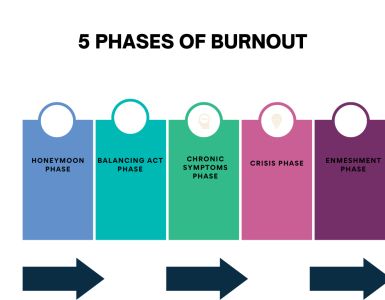Retain talent by getting different generations of employees to work well together
A leaked internal memo from Amazon reveals fears of running out of employees in two years. While it is possible to use AI to complement human labour, it is no replacement for employee retention and a cordial work environment. The logistics labour shortage is raging, forcing even the biggest companies to focus on talent retention.
With understaffing at the forefront, retirements are taking place in the industry, leaving even a bigger void. Baby boomers (between 57-75 years old) and older members of Generation X (between 41-56 years old) are retiring fast. The gap left by them will worsen the employee shortages. But worse, as they leave work behind, they take their work experience with them.
Millennials and Gen Z (Zoomers) have now entered the logistics workforce. According to DHL, Gen Z will make up the majority of the logistics workforce in just another 8 years. The tech-savviness of the new generation of workers is predicted to drive supply chain autonomy. Technologies like robotic process automation (RPA), machine learning (ML), and artificial intelligence (AI) are now becoming essential to the industry. The new generation of workers has grown up as digital natives. They are poised to bring digital transformation to companies that invest in young talent.
The new generation of employees is anxious about work performance but not hesitant to quit. Unlike the older generations, they do not hesitate to job hop. Gen Z is now changing jobs 134% more than they did in 2019.
At the same time, they are worried. 1 in 4 Gen Z employees thinks their education did not prepare them for the workplace. 34% worry about meeting employer expectations about work experience. Baby boomers and Gen X may not be as technologically sharp as the younger workers. But the decades of experience of older generations are essential for the new hands at the helm to navigate the chaos of an industry disrupted by Covid-19 and labour shortages.
Sadly, generation gaps at work always do not result in learning and cooperation. Some older managers think millennials and Zoomers are argumentative and impatient. Younger employees may think of older workers as out of touch.
Bridging this divide can create a workplace that is inclusive and welcoming across generations. It will also help the younger generation of workers smoothly transition to the industry while making the most of their skills with technology. For the organisation, it will result in positioning as an attractive place to work – making it easier to retain great talent.
The difference between generations
Giselle Kovary and Susan Armstrong, experts in training and development, presented how different generations view work at the Society for Human Resource Management (SHRM) Annual Conference & Expo 2021. It is important to note that every employee is an individual. It is possible to observe these patterns across groups, but individual differences and exceptions will still apply.
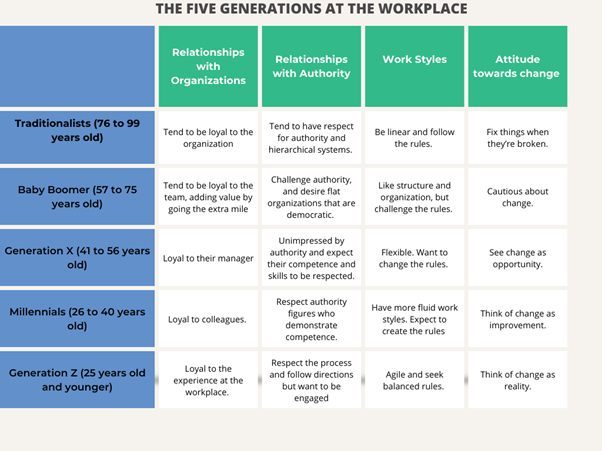
The differences in attitudes explain why sometimes conflict takes place between generations at work. Older managers might not understand the younger generation’s need for engagement – resulting in miscommunication and misunderstanding. Baby boomer and Gen X managers are also more conservative with their attitude towards change. Millennial and Zoomer employees might interpret this as resistance to change when new ideas are slow to get implemented.
As different generations have grown up in different eras, what they expect from work varies as well. Gen Z values regular peer and manager recognition nearly as twice as baby boomers and Gen X. Zoomers are also much more likely to pick work that is interesting to them even at less pay. It is clear that younger employees value engagement at work.
Jorge Mora, CEO of the logistics firm Southern Companies, shared his observations on how past generations and the new one’s view work.
I feel now with the younger generation, they have more of a sense of work/life balance, they understand that there is more to life than just getting up and going to work every day and then repeating. Whereas in past generations, that was how we were raised, you live to work and to provide for your family.
Jorge Mora, CEO of the logistics firm Southern Companies
This wasn’t a bad thing, but that view has shifted, more focus is on the well-being of families, spending time with them, and taking the time off needed to recharge so that you don’t burn out.
One thing we can learn from the younger generation is the enjoyment of life, not just work until you feel run down and to really work on finding a balance that enables you to feel satisfied both in work and your personal life.
And from a business owner perspective, I want employees with longevity and to have that you need to offer a place of employment where they feel they have those freedoms to take time off without feeling they are letting the company down. We want happy and satisfied employees because then they are able to provide better service to our clients.”
How leaders can create a company where every generation can thrive
Inspiring your team is a key skill for every leader. As the labour shortages continue and attitudes toward work shift, talent retention will become a priority for the C-suite in the coming years. Creating a company culture where people of all generations can thrive would require three things.
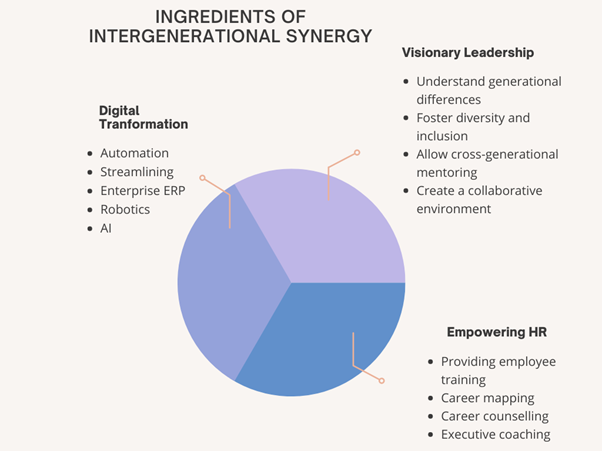
Visionary Leadership first required
A mindset shift in leadership is the first and foremost requirement. Without a strategic vision from top management, tactical measures will end up being window dressing. Leaders should foster these qualities in themselves and others as a first step. These actions would not only help intergenerational teambuilding, but they would help increase productivity and employee satisfaction as well.
- Understand generational differences: Different generations have grown up under different circumstances. This affects their worldview and values at work. Being familiar with these factors can help you to get the best out of your staff.
For example, Gen-Z grew up amidst social justice movements like #MeToo and discourse on mental well-being. This is one reason they prioritise mental health and workplace wellbeing more than other generations.
Baby boomers, especially in the US, grew up in a time of rapid economic growth after World War 2. This influences their goal-oriented behaviour, dedication to work, and the tendency of wanting to get things done themselves.
- Foster diversity and inclusion: According to McKinsey, diverse teams are 35% more creative and perform better, as opposed to homogenous teams. A company culture where people feel their views will be heard and respected is key to benefitting from the diversity of generations.
This requires leaders to have empathy and implement internal policies that support workplace equity. Diverseness and inclusion go beyond age differences and include differences in gender, ethnicity, and culture among others.
- Allow cross-generational mentoring: Older managers and employees can play a crucial role in mentoring younger employees. Younger employees can take a bigger role in leading technological innovation at work. Allowing the two groups to learn from each other in mutually beneficial ways can transform a workplace.
Mentoring is also a great way to keep employees engaged and retain talent. Mentors and mentees have retention rates close to 70%, as opposed to the 50% for employees not involved in a mentoring program.
- Create a collaborative environment: Collaboration can lead to better ideas, prevent costly mistakes, and create great workplace synergy. In some companies, older employees may see themselves as superior to younger employees, based on age and level of experience. This view could be reinforced by the wider culture outside work as well. Genuine collaboration requires clear communication, well-defined goals, and mutual respect.
After the pandemic, the majority of companies now use digital collaboration tools. While younger employees may be naturally good at using them, some older employees could be hesitant to change. Leaders should manage the transition and get the buy-in of older employees if this is the case.
Digital transformation to allow employees to focus on work that matters
After visionary leadership, the digital transformation of a company is the next step. Automating rotework and streamlining processes will save valuable time. This allows managers to do more strategic work of planning, mentoring, and supporting their team members. It allows employees to free up their time to learn and develop themselves at work as well.
After the pandemic, the majority of the post-pandemic workforce wants remote or hybrid work. Therefore, technology that facilitates remote work has become crucial in attracting talent. Nearly half of Gen Z workers want hybrid work. Millennials are the leading generation who want to work completely remotely. Companies who insist on doing things the old-fashioned way would be a hard sell in the future of work.
Empower the Human resources department
Last but not least, reevaluating the role of your HR department would be a great third step. Many HR leaders think it is high time that human resources stop doing routine admin tasks and takes over strategic advising. Digital streamlining will help your HR team to do this and spend time on tasks that uplift your staff. An empowered HR department can take actions as below to create intergenerational cooperation.
- Providing employee training: Workers across the generations are unhappy with the training they receive from their employers. Only 39% overall say they are satisfied. Employers who provide skill development in the form of internships, shadowing, and on-the-job training can get an edge in the retention and search for talent.
Soft skills like communication, empathy, and leadership could be included as part of employee training to help different generations get along well with each other. Older employees could be involved as mentors for interning and shadowing.
- Career mapping: Not having growth opportunities is a key reason why employees leave companies. For 63% of US workers who quit their job in 2021, lack of opportunities for advancement was a reason to leave.
Another 2021 survey found that 80% of workers think their employer does not offer growth opportunities. One way companies can address these worries is by doing career mapping. Human resources can play a crucial role in this and help retain talent.
Career mapping helps younger Gen Y and Z employees transition smoothly into more senior roles. It also reinforces the worth of older employees when implemented together with mentoring and training.
- Career counseling: There’s bound to be conflict and difficulties when working with people across generations. Career counseling, provided in-house or by an outside expert, can help employees resolve these and move forward.
As with all other forms of counseling, confidentiality and nonjudgement are key for good career counseling. Employees may not want to talk to an in-house counselor if they feel what they say in confidence will be shared outside. They may also not want to avail of career counseling if the company culture frowns on admitting you need help.
- Executive coaching: Executive coaching is done by outside coaches for senior leaders or high potential employees to improve their leadership skills. A good executive coach can help leaders with learning how to work with different generations on a one-on-one basis.
According to SHRM, coaching is most effective for people in career transitions (promotions, moving into management, etc). Therefore, executive coaching can be used to help employees who will be responsible for managing intergenerational teams.
Vidusha Nathavitharana, HR consultant and leadership trainer, commented on how human resources can go about doing this work.
“HR’s role is to create ‘eco systems’ that facilitate this and become enablers of it. For example, creating a policy and procedural framework that gives the charge of senior employees to act as career mentors for selected juniors and having a development KPI for the senior based on how the junior performs and progresses will help the two groups to work very closely. And also, ensure they take each other very seriously.
HR can, and should play an ‘architect’ role here: ensuring that the frameworks are set, and also, practically implemented.”
Vidusha Nathavitharana, HR Consultant and Leadership Trainer
CargoWise and SFL will release time for the important work
To reap the benefits of diversity in different generations, there needs to be corporate culture and leadership that allows diversity to thrive. This can take a while even for the most committed C–suite. Digital transformation, however, is something that you can get started today, while you bring in a new way of leadership.
Get in touch with SFL today to discuss the implementation of CargoWise Enterprise ERP. CargoWise will help you automate and eliminate repetitive tasks and busy work, freeing up time for your team across departments. It will help you move forward your company towards a future where talent retention and collaboration across differences are the norms.
Book a free discovery call with an SFL representative to see how we can help you.



